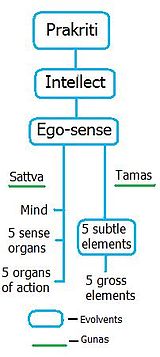Prakṛti
Prakriti or Prakruti (Sanskrit: प्रकृति IAST: prakṛti) is "the original or natural form or condition of anything, original or primary substance".[1]
It is a key concept in Hinduism, formulated by its Sāṅkhya school, where it does not refer to matter or nature, but "includes all the cognitive, moral, psychological, emotional, sensorial and physical aspects of reality," stressing "prakṛti's cognitive, mental, psychological and sensorial activities."[2]
Prakriti has three different innate qualities (guṇas), whose equilibrium is the basis of all observed empirical reality.[3][4]
Prakriti, in this school, contrasts with Puruṣa, which is pure awareness and metaphysical consciousness.[3] The term is also found in the texts of other Indian religions such as Jainism[5] and Buddhism.[6]
Etymology and meaning[edit]
Prakriti (Sanskrit: प्रकृति) is an early Indic concept, which means "making or placing before or at first, the original or natural form or condition of anything, original or primary substance."[7] The term is discussed by Yāska (~600 BCE) in Nirukta, and found in numerous Hindu texts.[7] It connotes "nature, body, matter, phenomenal universe" in Hindu texts.[8][9]
According to Dan Lusthaus,
Panch Prakriti[edit]
In Indian languages derived from Sanskrit roots, Prakriti refers to the feminine aspect of all life forms, and more specifically a woman is seen as a symbol of Prakriti.[8]
In Hinduism, the concept of Prakriti is thoroughly mentioned. According to Sanskrit scriptures, Brahma Vaivarta Purana, Devi Mahatmya and Devi Bhagvata Purana, five Hindu goddesses are considered as the complete feminine personification of Prakriti - Saraswati, Lakshmi, Parvati, Gayatri and Radha. Together these five goddesses are worshiped as Panch Prakriti.[10]
Application in Indian philosophy[edit]
In the Sāṅkhya and Yoga philosophical literatures, it is contrasted with Purusha (spirit, consciousness), and Prakriti refers to "the material world, nature, matter, physical and psychological character, constitution, temper, disposition". According to Knut Jacobsen, in the dualistic system of the Samkhya school, "Purusha is the principle of pure consciousness, while Prakriti is the principle of matter", where Purusha is the conscious witness in every living being, while Prakriti is the manifest world.
In Hindu cosmology, Prakṛti is the feminine aspect of existence, the personified will and energy of the Supreme (Brahman); while in Shaktism, the Goddess is presented as both the Brahman and the Prakṛti. In Samkhya-Yoga texts, Prakriti is the potency that brings about evolution and change in the empirical universe. It is described in Bhagavad Gita as the "primal motive force".[11] It is the essential constituent of the universe and is at the basis of all the activity of the creation.[12]
In Vishishtadvaita Vedanta, Prakṛti is one of the six substances (Dravya). The Guṇas (qualities) are the attributes of primordial Nature (Prakṛti), and not its constituents, unlike Sāṅkhya.[13] These qualities are inseparable from Prakṛti, but not identical with it and inextricably related to Ishvara. Prakṛti in Vishishtadvaita Vedanta is limited above by the eternal manifestation (nityavibhuti) whereas it's infinite in Sāṅkhya.[14]
According to Dvaita Vedanta, Prakṛti is the material cause (Satkaryavada) of the world.[13]
Prakriti is closely associated with the concept of Maya within Hindu texts.[15]
In Jainism the term Prakriti is used in its theory of Karma, and is considered "that form of matter which covers the perfections of the soul (jiva) and prevents its liberation".[16]
According to Samkhya and the Bhagavad Gita Prakrti or Nature is composed of the three gunas which are tendencies or modes of operation, known as Rajas (creation), Sattva (preservation), and tamas (destruction). Sattva encompasses qualities of goodness, light, and harmony.[17] Rajas is associated with concepts of energy, activity, and passion; so that, depending on how it is used, it can either have a supportive or hindering effect on the evolution of the soul.[18] Tamas is commonly associated with inertia, darkness, insensitivity. Souls who are more tamasic are considered imbued in darkness and take the longest to reach liberation.[19]
See also[edit]
프랙티티
| 인도 철학 - 인도 발상 종교 |
| 힌두교 |
|---|
 |
프랙티티 ( 산스크리트 प्रकृति, prakṛti)는 삼키야 학파 가 접하는 물질원리 [1] .
알파벳에서는 prakrti, prakriti, prakruti 등으로 표기되어 있는 경우가 있다. 일본어로는 「프라크리티」나 「프라크루티」등 가타카나 표기가 일반적이지만, 굳이 한자 표기하는 경우는 근본 원질로 번역된다.
개요 [ 편집 ]
잔키야 학파는 순수한 정신 원리의 프루샤와 물질 원리의 프랙티티의 두 가지를 실재하는 것으로 생각하고 있으며, 그 한쪽에 해당하는 것이다 [1] . 잔키야 학파에서는, 프루샤 는 모든 물질성을 배제한 존재라고 여겨진다. 그에 비해 프랙티티라는 단 하나의 물질원리에 의해 이 세계의 물질적인 것이 생겼다고 한다 [1] .
존재론적으로 말하면, 프랙티티는 현상 세계의 근원적 물질이며, 현상적 존재(개별물)는 모두 프랙티티의 변화에 의해 생긴 것으로 한다 [1] . 따라서 pradhāna 프라다나 (= 첫 번째 원인)라고도합니다. [주석 1]
해탈론적으로 말하면, 삼키야 학파는 프랙티티는 신체의 모든 물질적 요소를 가리키는 것으로 사용되고 있다. 동학 파는 해탈 이란 프루샤가 프랙티티(모든 신체적 요소)와는 다른 존재임을 인식한다고 했다 [1] .
참고 문헌 [ 편집 ]
- Gerald James Larson, Classical Samkhya: An Interpretation of Its History and Meaning . (Sāṃkhyakārikā의 영어 번역 포함)
- 『철학 사상사전』 이와나미 서점, 1998년. 모기 히데아츠 집필 pp.1395-1396【프랙티티】

